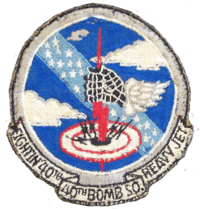40th Expeditionary Bomb Squadron
| 40th Expeditionary Bomb Squadron | |
|---|---|
|
Emblem of the 40th Expeditionary Bomb Squadron | |
| Active | 1944–1967; 2000s (decade) |
| Country | United States |
| Branch | United States Air Force |
| Type | Bombardment |

The 40th Expeditionary Bomb Squadron is a provisional United States Air Force unit. It is assigned to the 40th Air Expeditionary Wing, possibly stationed at Diego Garcia. Its current status is undetermined.
History
B-29 Superfortress operations against Japan
Established as a B-29 Superfortress heavy bomb group in early 1944; trained under Second Air Force in Nebraska. Initially trained with B-17 Flying Fortresses until B-29 aircraft were manufactured and assigned to the unit.
Deployed to Tinian, Northern Mariana Islands in December 1944. Entered combat by flying navigational escort for a major attack force bound for Iwo Jima. The squadron then struck Tokyo and other major Japanese cities and facilities during daylight high-altitude bombing raids, with crippling, non-stop incendiary raids which destroyed lines of communication, supply, and numerous kamikaze bases. On 25 May 1945, the squadron flew a low-altitude night mission through alerted enemy defenses to drop incendiary bombs on Tokyo, for which they received their first Distinguished Unit Citation.
In addition to incendiary raids, the 40th also participated in mining operations. By mining harbors in Japan and Korea in July 1945, the squadron contributed to the blockade of the Japanese Empire earning their second Distinguished Unit Citation. The 40th's final World War II mission came on 14 August 1945, with the dropping of 500-pound general purpose bombs on the Marifu railroad yards at Iwakuni.
With the war over, the squadron dropped food and supplies to Allied prisoners of war and took part in show-of-force flights over Japan. Aircraft and were returned to the United States in late 1945; unit remained assigned to 20th Air Force primarily as an administrative unit where it was unequipped; finally inactivated in 1948.
Strategic Air Command
Reactivated in January 1951 due to expansion of the Air Force due to the Cold War. Equipped with B-36 Peacemaker intercontinental strategic bombers. Initially was equipped with B-36Fs. Later Featherweight III B-36Js were added, the squadron operating both types. Carried blue stripe on the tip of the vertical stabilizer; the lip of the jet intakes and the "nose cone" of the jet itself along with triangle-R tail code. SAC eliminated tail codes in 1953. In September 1957, the B-36s were replaced with B-52E Stratofortress aircraft and all squadron markings were eliminated. Continued strategic bombardment training until 1967 when the squadron was inactivated with the closing of Walker AFB.
Reactivated as a provisional B-52H strategic bomb squadron as part of the Global War on Terrorism in 2002. Engaged in combat operations over Iraq and Afghanistan. Suspected to have ended combat operations in 2006; current status is undetermined.
Operations and Decorations
- Combat Operations: Combat in Western Pacific, 27 Jan-14 Aug 1945.
- Campaigns: Air Offensive, Japan; Eastern Mandates; Western Pacific.
- Decorations: Distinguished Unit Citations: Tokyo, Japan, 25 May 1945; Japanese Empire, 9–19 Jul 1945. Air Force Outstanding Unit Award: 1 May 1960 – 31 May 1962.
Lineage
- Constituted 40th Bombardment Squadron (Very Heavy) on 28 Mar 1944
- Activated on 1 Apr 1944
- Inactivated on 18 Oct 1948
- Redesignated 40th Bombardment Squadron (Medium) on 20 Dec 1950
- Activated on 2 Jan 1951
- Redesignated 40th Bombardment Squadron (Heavy) on 16 Jun 1952
- Inactivated on 25 Jan 1967
- Redesignated 40th Expeditionary Bomb Squadron and converted to provisional status 31 Jan 2002
- Current status undisclosed
Assignments
- 6th Bombardment Group, 1 Apr 1944 – 18 Oct 1948; 2 Jan 1951
- 6th Bombardment (later Strategic Aerospace) Wing, 16 Jun 1952 – 25 Jan 1967
- 40th Air Expeditionary Wing, 31 Jan 2002-TBD
Stations
- Dalhart Army Air Field, Texas, 1 Apr 1944
- Grand Island Army Airfield, Nebraska, 26 May-18 Nov 1944
- North Field, Tinian, 28 Dec 1944
- Clark Field, Philippines, 13 Mar 1946
- Kadena AB, Okinawa, 1 Jun 1947 – 18 Oct 1948
- Walker AFB, New Mexico, 2 Jan 1951 – 25 Jan 1967
- Diego Garcia, 31 Jan 2001-TBD
Aircraft
- B-17 Flying Fortress, 1944
- B-29 Superfortress, 1944–1947; 1951–1952
- B-36 Peacemaker, 1952–1957
- B-52 Stratofortress, 1957–1967; 2002-TBD
See also
References
![]() This article incorporates public domain material from the Air Force Historical Research Agency website http://www.afhra.af.mil/.
This article incorporates public domain material from the Air Force Historical Research Agency website http://www.afhra.af.mil/.
- Maurer, Maurer, ed. (1982) [1969]. Combat Squadrons of the Air Force, World War II (PDF) (reprint ed.). Washington, DC: Office of Air Force History. ISBN 0-405-12194-6. LCCN 70605402. OCLC 72556.


.png)